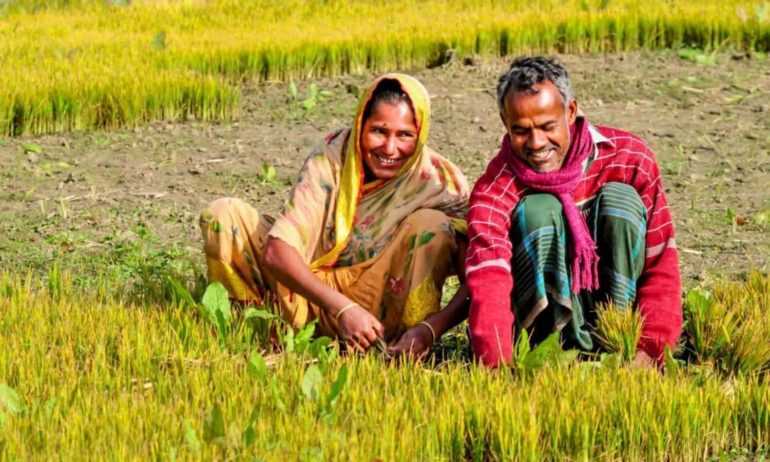The International Food Policy Research Institute (IFPRI) recently released the annual Global Food Policy Report. The 2014-2015 report, the fourth in the series provides an overview of major events and policy decisions from 2014 and potential opportunities and challenges that may be encountered in 2015.
2014 produced many major advances in food and nutrition security around the globe. A fall in food prices resulted in the lowest world food prices since 2010. The share of the world’s people who are hungry continued to fall last year, and experts now believe that the goal of cutting the number of hungry people in half is nearly attainable. The Millennium Development Goal (MDG) of halving global poverty by 2015 was achieved. Additionally, middle income countries (MICs) are scaling up efforts to improve food and nutrition security. Brazil’s Zero Hunger—designed to eradicate hunger and extreme poverty through a variety of innovations, including direct financial assistance to the poorest families, low-cost restaurants, nutrition education, and supporting subsistence family farming. In addition, Bolsa Familia, a welfare program that scaled up and coordinated scattered existing initiatives under a single program, helped halve Brazil’s poverty and led to a fall in income inequality. Additionaly, Oportunidades, a mexican anti-poverty program, focused on helping poor families by investing in human capital lead to improved education, health, and childhood nutrition.
Africa also made major strides in tackling food insecurity and poverty. Gross domestic product (GDP) and GDP per capita for Africa as a whole rose, agricultural growth for Africa as a whole has been strong, and poverty and hunger reduction grew at a slow but steady pace. At the African Union (AU) Summit, the AU committed to end hunger and halve poverty by 2025 and to agriculture-led grown as part of the Malabo Declaration.
On a much broader scale, as the MDGs are due to expire the Sustainable Development Goals (SDGs) will be adopted at the end of the year. These goals will build upon the previous goals, accomplishments, and shortcomings.
Closely linked to food and nutrition security, several major advances in battling malnutrition were made as well. At the Second International Conference on Nutrition (ICN2) in Rome, actions to end malnutrition were proposed. The U.N. Food and Agriculture Organization (FAO) set up the Action for Nutrition Trust Fund, which will mobilize funds for nutrition interventions and enable countries to establish tools and procedures against which they can monitor their progress towards ICN2 goals. On a larger scale, thanks to new research and experts stressing its importance, nutrition rose to the top of the global development agenda in 2014, according to IFPRI’s report. Many important factors contributing to malnutrition were also recognized, including drinking water, sanitation, the role of women, and quality of care giving. These realizations are proving helpful in developing meaningful policies, such as finding ways to improve sanitation in rural India to improve health outcomes. Furthermore, obesity and micronutrient deficiencies are not considered forms of malnutrition.
Significant progress in fighting climate change was seen as well. In the first major sign of international cooperation in years, the United States and China reached an historic bilateral deal and have committed to reduce emissions after 2030. The UN Climate Conference in Lima, Peru, developed a new basis for lowering greenhouse gas emissions. Each country was given six months to submit a proposal for reducing emissions in 2015. This foundation will be built upon at the UN Climate Change Conference in Paris this year. Climate-smart agriculture is also gaining a foothold. The U.N Framework Convention on Climate Change in Peru in September launched the Global Alliance for Climate-Smart Agriculture, a collaboration between governments, scientists, farmers, non-governmental organizations (NGOs), and businesses that aims to secure food security in the face of climate change. In addition, the International Fund for Agricultural Development (IFAD) and the World Bank committed to making all of their agricultural investments, believed to total about US$11 billion, climate-smart by 2018.
There were also some setbacks and shocks that the report acknowledges. The largest-ever Ebola outbreak caused disruptions in agriculture and food production, harvesting, transportation, and sales, resulting in increased food prices and insecurity in sub-Saharan Africa. Many experts fear that these resulting vulnerabilities could lead to a negative feedback loop: malnutrition leads to more illnesses, causing negative socioeconomic impacts and increased malnutrition. Continued conflict around the globe, such as those seen in Syria, Iraq, and Yemen, impose negative consequences for nutrition and wellbeing for refugees and neighboring countries. Extreme weather conditions, including droughts and natural disasters, threaten the food supply, and small farmers who are most vulnerable to these climate-related shocks.
Through all of the advances and setbacks, the report has strong hope for the future, viewing 2015 as a “window of opportunity to reshape the global development agenda.” The report concludes that the “momentum garnered for food and nutrition security in 2014 can be leveraged into post-2015 SDGs that enhance or foster holistic and comprehensive nutrition investments, policies, and programs, the international community may soon have a chance to end hunger and malnutrition once and for all.”











